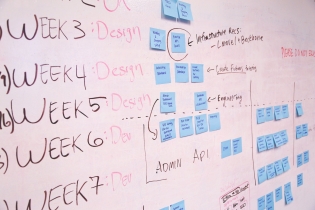We are living in a world where mobile phones touch almost every aspect of our lives. We use apps for marketing, to communicate, order food, and even send money to our loved ones. As the mobile devices continue to evolve in terms of technology, the more enticing they become. It’s estimated that most adults in the US spend more than 3 hours per day on mobile devices. Of these three hours, mobile apps account for more than 90% of the internet time.
This high affinity for mobile phones use is as a result of the high mobile phones penetration coupled with an increasing demand for tech professionals like iOS developers - explanation. According to a recent report by Statista, there were more than 5 million mobile apps in 2017 on both Apple’s App Store and Google Play Store with the number expected to continue growing. In terms of revenue, the global mobile app industry is expected to rake in $189B in revenues by the year 2020.
.
It shouldn't then come as a surprise that in the next few years, mobile phones are expected to surpass TV as the medium with the highest time consumption affinity globally.
.
In this article, we are going to show you why you need an app as a business and how much it will cost you.
.
Why Does Your Business Need an App?
We are operating in a digital environment and any business looking to stay afloat should be gravitating towards being multi-channel. For this reason, having an effective presence in these multiple channels allows your business establish contact with potential customers at the same time augment your customer support systems.
.
Mobile apps can also help increase your company’s profits. As of 2018, there are more than 2.5 billion smartphones globally which is a significantly big market for businesses to target customers in their marketing. For instance, businesses can engage in mobile app marketing by utilizing interactive notifications to motivate and attract customers to buy from them.
.

Types of Mobile Apps
There are three major types of mobile apps.
Native Apps
There are apps that are coded in a specific programming language like Objective-C or Java. they are fast and highly reliable although they are tied to a particular operating system.
.
Hybrid Apps
These types of apps combine the attributes of both native and Web applications. They are developed using Javascript, HTML, and CSS and hosted in a native application allowing you to alternate the web-native framework as you wish.
.
Web Apps
These types of apps are stored in a remote server and accessed over the Internet via a browser interface.
.
Now that we have looked at the types of apps, let’s delve a little deeper into the specifics…
.
Almost 99.6% of smartphones currently operating run on either Apple or Android making it a two-horse race. On a global scale, the iOS market is dominated by Android with an 80% market share followed by Apple with a 15% stake. However, Apple is still way ahead in terms of revenue compared to Android despite having the largest market share.
.

So, which one should you pick?
Basically, both the iOS and Android platforms are great. However, there are two major considerations that you should have in mind before settling for any:
- Your customers/ users.
- The opportunity cost.
.
The term opportunity cost here means the tradeoffs you are willing to accommodate in case you choose one platform over another. For instance, Apple has a higher threshold and stricter guidelines which can only translate into one thing-- high-quality secure apps. As such, you may decide to tradeoff the high maintenance costs with quality.
The second but equally important aspect is your users. For instance, if you are operating in a country like the US, you may want to consider an iOS app as its the largest iPhone market in the world.
Why not develop both the Android and iOs? You may ask…
Well, theoretically you can. However, this may prove a costly venture especially for a business at the infant stages. So, why risk bankruptcy whereas one can serve the purpose? After all, you can choose to be the IT project manager as the development team does the heavy lifting for you.
.
What Does it Take To Build an iOS App
As earlier indicated, Apple has a very strict review guideline on the quality of apps they allow on their platform. Before you even consider developing your app, its good to compare your blueprint and their rules to ensure they match. Otherwise, what's the point of developing something that will be eventually rejected?
With that in mind, here are the ideal iOS app programming languages you can deploy for your projects.
Objective-C
Objective-C is a traditional programming language used in most if not all iOS and OS X operating systems. It is an object-oriented and general purpose language famous for its low-level features and objects accommodation. The language uses both static and message typing which is almost similar to the one used in Smalltalk programming language.
Swift Programming Language
Developed in 2014, Swift is set to become a force to reckon with for all iOS development projects. The language has been hailed for its simpler syntax compared to Objective-C.
React Native
So far, this is the best alternative for a mobile app developer using traditional programming languages. With this language, a developer can build authentic native applications using JavaScript.
XCode
When looking to code, compile, and build an iOS app from source code, this is the to go to IDE.
IOS Application Lifecycle
Making a mobile an iOS app is a calculated process that involves extensive pre-planning. Below is a brief overview of the different development phases that will help you create apps that capture your client’s imagination.
Pre-Planning
Pre-planning is the initial and probably the most crucial stage in app development. It allows you to put into place the foundational requirements and lays the groundwork for the next stage. It's at this stage that you brainstorm and conduct a thorough research by asking questions like--what is the objective of your app? What are your customers saying? Etc
By answering all these questions, you are essentially trying to establishing whether your application will meet its objective or not.
Visual Prototyping
The second step is mental prototyping and it involves laying your ideas on a piece of paper. After a detailed brainstorming session to determine the app’s cost, you need to add flesh to your app ideas. This way, you get to know any supplementary requirements of the app and the overhead expenses that may arise due to unplanned development work.
Technical Feasibility Assessment
Your app design and back-end functionality are worlds apart. For this reason, you need to harmonize the back-end system with the app functionality without compromising on your design. To ensure this happens, you must utilize a public API as it helps you settle on the platform your app is to be launched on.
Building a Prototype
Before commencing the mobile app development, you need to have a prototype laying down a clearly-defined preview of the final product.
In the course of this process, you are also able to establish the functionality and loopholes in your app and make the necessary adjustments.
Designing
At this stage, you will be required to bring on-board a UI/UX designer to help you put together the blueprint that will shape your final app. Ensure they get you a beautiful and stunning design coupled with a user-friendly interface, flow, etc.
Mobile App Development
The next step involves hiring a team to create an app bestowed with intuitive features that improve user experience and apt enough continue to evolve with the trends.
Create Developer’s Account
Consequently, you are required to register with the respective app stores where you will be launching your app--in this case Apple. The platform charges an annual fee of $99.
Integrate Analytics
An app is a business in itself. For this reason, you need to know whether it’s achieving the intended purpose. For this, you need to integrate analytics to help track the user engagement, retention rate, and the number of downloads.
Now that we have the development stages out of the way, let’s have a look at the cost of iOS app development.
iOS App Development Cost
Right off the bat, there isn’t a standardized rate when looking to develop a mobile iOS app. Your business model, the platform, functionality, and design level you have chosen are all baked into the total mobile application development cost. There are also “subjective” costs associated with hiring a development team.
Even if you are looking to build relatively simple cross-platform mobile apps, it is highly likely that you will be needing a team of developers to execute your iOS mobile app development project.
Using the lowest hourly rate in the US which is $100, this survey found out that it would take anything between $25,275.00 to $114,300.00 to build an iOS app. On the other hand, a $150 hourly rate means you would have to cough between $37,912.50 to $171,450.00.
It goes without saying, these numbers depict the initial development costs. Once the app is up and running, you will need to factor in maintenance and update costs.
.
Why You Should Choose Offshore Development as a Startup
To meet the modern customers’ demand, you need an experienced team that can rapidly develop and modify the code as needed. With the business environment continuously evolving, a startup with limited funding may have to hire remote employees.
Here are the benefits of working with an offshore development team:
Lower Costs
Due to financial constraints, many startups end up failing to implement some of their mobile commerce strategies. Through outsourcing, you can minimize the operational expenses such as the product manager salary and employee attrition related costs.
Over the years, there has been a consistent deficiency of tech talent pool coupled with an upsurge of iOS developer jobs. With an offshore team, there is an already assembled team waiting to work on your projects without following traditional hiring practices.
Improve Productivity
Having an internal team may at times mean overly stretching your resources as they have numerous tasks to tackle on a daily basis. By working with an offshore team, you get to work with experienced individuals who solely focus on your project which improves productivity.
Faster Turn-around Time
iOS mobile development is not a linear process which makes it time-consuming. Any slight mishap right from the mobile app design all the way to deployment may result in additional costs. This compounded by hiring, training, and onboarding bottlenecks could spell even bigger problems.
With an outsourced software development team, your company is exposed to well-trained teams solely dedicated to your project and armed with a deep understanding of the necessary methodologies to effectively and efficiently complete your project.
Final Thoughts
The cost of building a mobile app is subjective and wildly varies like purchasing a piece of real estate. There are multiple things that are baked into the overall development cost making it almost impossible to pinpoint the exact formula. With that said, whether you are dealing with a brick and mortar or an e-commerce business, a mobile app is a worthy investment that helps increase sales and revenue. If you are not a techwiz wondering how to make a mobile app, outsourcing is one of the best hiring methods especially if you are strapped of cash.








